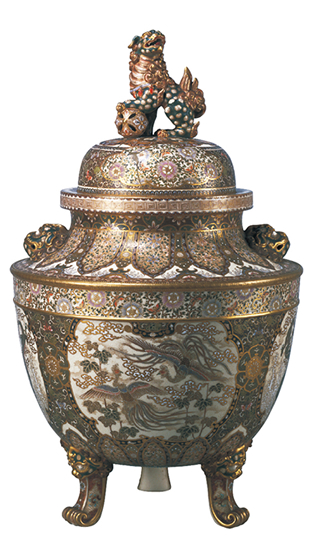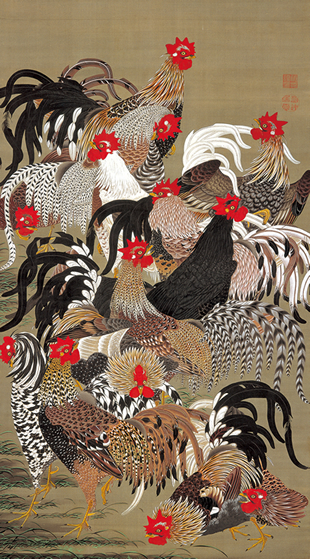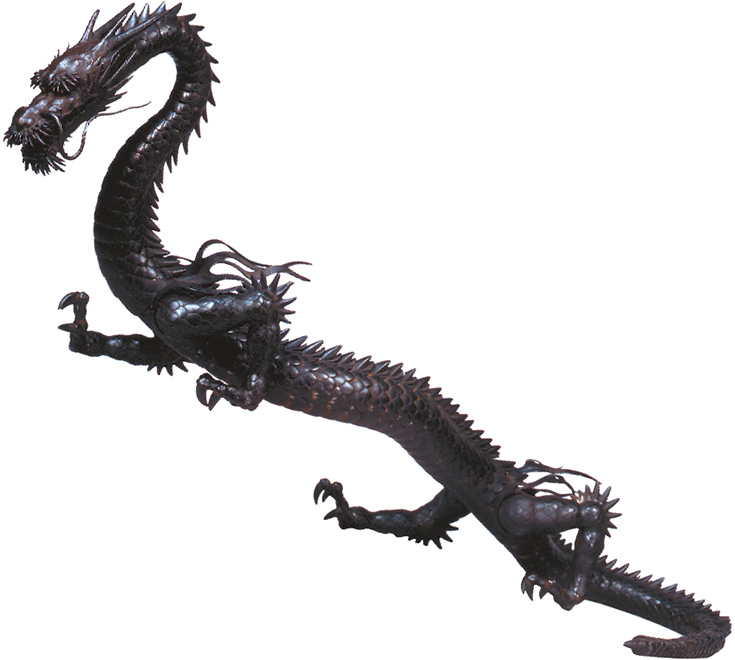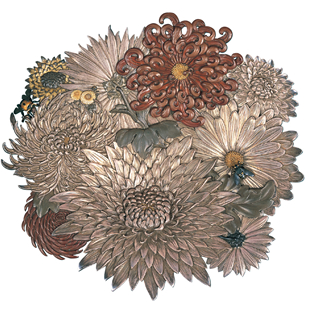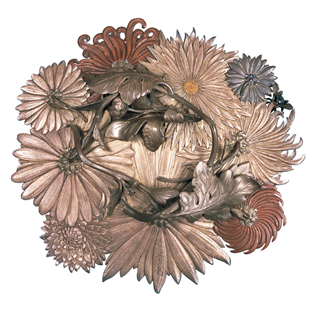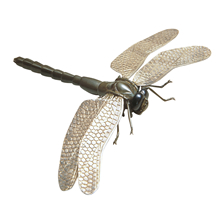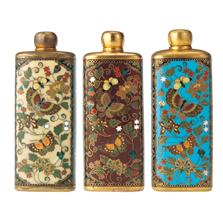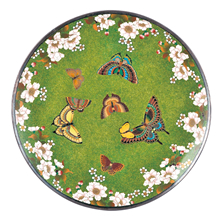niponica is a web magazine that introduces modern Japan to people all over the world.
2015 No.17
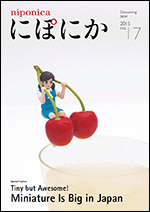
To read the e-book you need to have JavaScript enabled in your browser and a free Flash Player plug-in from Adobe Systems Inc. installed.
Miniature Is Big in Japan

The Traditional Decorative Arts of Japan, on a Minute Scale—
Magnificent and Meticulous

Ceramic urn elaborately decorated with gold and colored illustrations, made for export during the Meiji period (1868-1912) to cater to overseas demand. Object name: Iroe karakusamon shishi chu kazariko (“Colored Pot Decorated with Arabesque Pattern and Lion”). Made by Kinkozan Sobe’e. Height 46.4 cm; diameter 23.2 cm. Property of the Tokyo National Museum. Image: TNM Image Archives.
A masterpiece by Ito Jakuchu, showing a tight flock of thirteen fowl in splendor and great detail. Jakuchu, a painter active in the 18th century, has left us many illustrations of animals and plants. Name of this scroll illustration on silk: Gun-kei-zu: Doshoku sai-e (“Illustration of a Flock of Fowl: Colorful Realm of Living Beings”). 142.6 x 79.7 cm. Property of Sannomaru Shozokan (The Museum of the Imperial Collections).
Global fascination for Japan’s decorative arts
Official policy cut the country off from the outside world during most of the Edo period, although the export of ceramics, lacquer ware and other works decorated with ornate patterns was permitted from the port of Dejima in Nagasaki, bound for Europe. After the country opened up and political circumstances changed with the Meiji period (1868-1912), many more works of art were sent overseas, helping to meet the government’s foreign currency needs. The first time Japan exhibited in a world fair was the Paris Exposition of 1867. This was followed by exhibitions in Vienna, Philadelphia and elsewhere, all offering opportunities for the presentation of Japan’s decorative arts. The response was enthusiastic.
Western aesthetic curiosity for Japan led to Japonisme fads in the latter part of the 19th century and the early part of the next. It is well known that the Impressionists were strongly influenced by ukiyoe woodblock prints. But Japan’s decorative arts also struck the eyes of European artists as highly innovative, especially the choice of insects for motifs, and inlay works that combined metals of different colors. Émile Gallé (1846-1904) and René Lalique (1860-1945) are good examples of the art nouveau masters whose works include insect and bird motifs. In Japan, within the history of nature motifs, cultural trends had favored the flowers, birds, insect sounds and other natural phenomena of the current season since the Heian period (794-1192). Ito Jakuchu (1716-1800) and his contemporaries drew meticulous illustrations with insect and bird motifs, basing their work on realistic sketches, and above all, their art still attracts admiration today.
The Meiji Restoration ended the Edo period, and the rank of samurai was abolished. When a decree was issued prohibiting the carrying of swords, metalwork artisans faced the risk of losing their jobs. What saved them was keen overseas demand for their work. Eager to encourage industry, the Meiji government promoted the export of industrial arts, bringing renewed prosperity to metalworkers.
Another example of Japanese art attracting the attention of overseas markets is jizai okimono, lifelike models of animals and insects assembled from intricately worked metal pieces but look so realistic they seem alive. Such works were discovered by art lovers outside Japan during the Meiji period, and this resulted in the export of superior pieces. Meanwhile, in the Japan of today, the surprising sophistication of the various forms created by the armor craftsmen of Edo is finally attracting the respect it deserves.
The spirit of traditions that paid such exquisite attention to detail remains alive even today in the cornerstone of Japanese industry, manufacturing. And all those figurines and other modern trinkets that seem to have adopted the role of netsuke toggles, like key chains and cellphone straps, display the same fondness for detail, as is also seen in elaborate miniature figurines.
Kurokawa Hiroko
Associate professor at the University Art Museum, Tokyo University of the Arts, and specialist in the history of early modern Japanese industrial art and handcrafts. Author of Meiji Taisho Zuan-shu no Kenkyu: Kindai ni Ikasareta Edo no Dezain (“How Edo Design Influenced the Art of Early Modern Times: A Study of the Meiji and Taisho Periods”), and other works.
Top: Metal model of a jizai okimono dragon with many moveable parts, including legs, claws and mouth. Made by Myochin Muneaki, a maker of military armor. Object name: Jizai ryu okimono (“Dragon, Jizai Articulated Figure”). Length 136.5 cm. Property of the Tokyo National Museum. Image: TNM Image Archives.
Bottom: Plates made from a combination of different colored metals: gold, silver and bronze. During the Meiji period (1868-1912), metalworkers specializing in decorative swords turned their skills to ornamental metal. Object name: Kiku-ka mushi zu-zara (“Plates Illustrated with Chrysanthemum Flowers and Insects,” front and back). Made by Shoami Katsuyoshi. 5.9 x 27.7 x 25.9 cm. Property of the Hayashibara Museum of Art.
Dragonfly, one in the jyunishu konchu series of 12 varieties of insects rendered as jizai okimono ornaments with moving parts. This insect’s wings and legs can be moved. Made by Takase Kozan. Length 7.5 cm. Property of the Mitsui Memorial Museum.
Small shippo perfume bottles with intricate illustrations. Object name: Kacho-mon kosui-bin (“Flower and Butterfly Motif Perfume Bottles”). Made by Namikawa Yasuyuki. Height 8 cm. Property of the Kiyomizu Sannenzaka Museum; photos: Kimura Yoichi.
Shippo (cloisonné enamel) plate with butterfly and cherry blossom motif. Made by Namikawa Yasuyuki. Japan’s shippo art earned rave reviews when it was exhibited at the Paris Exposition in 1889. Object name: Ochozu hira-zara (“Plate Illustrated with Cherry Blossoms and Butterflies”). Diameter 24 cm. Property of the Kiyomizu Sannenzaka Museum; photos: Kimura Yoichi.





